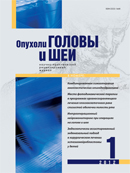ENDOSCOPE-ASSISTED ENDONASAL APPROACH IN THE SURGICAL TREATMENT OF ESTHESIONEUROBLASTOMA IN CHILDREN
- Authors: Merkulov O.A.1
-
Affiliations:
- Department of Neurosurgery, Morozov Children’s City Clinical Hospital, Moscow
- Issue: Vol 2, No 1 (2012)
- Pages: 37-41
- Section: ORIGINAL REPORTS
- Published: 14.04.2012
- URL: https://ogsh.abvpress.ru/jour/article/view/28
- DOI: https://doi.org/10.17650/2222-1468-2012-0-1-37-41
- ID: 28
Cite item
Full Text
Abstract
This trial was undertaken to examine 3 patients aged 7 months to 13 years with esthesioneuroblastoma were examined to evaluate the possibilities and efficiency of an endoscopic endonasal approach in its surgical treatment in pediatric practice. Additional orientation was provided by a Vector Vision Compact system (Brain Lab, USA). The trial has established that the endoscopic endonasal approach to creating an isolated transnasal and combined transnasal/transethmoidal corridor and a transcribriform approach is highly effective and reasonably safe for the treatment of children with esthesioneuroblastoma: no intra- and postoperative complications were recorded in the trial; analysis of the immediate results of surgical interventions has shown a clinical regression in all the patients. Fatal outcomes and recurrent tumor were absent in the late (1–5-year) period. The additional employment of the navigation equipment allowed one to more accurately use surgical tools in the narrow anatomic spaces and to more thoroughly affect an abnormality, which was eventually shown in more conservative surgery.
About the authors
O. A. Merkulov
Department of Neurosurgery, Morozov Children’s City Clinical Hospital, Moscow
Author for correspondence.
Email: 9166718244@mail.ru
Russian Federation
References
Supplementary files







